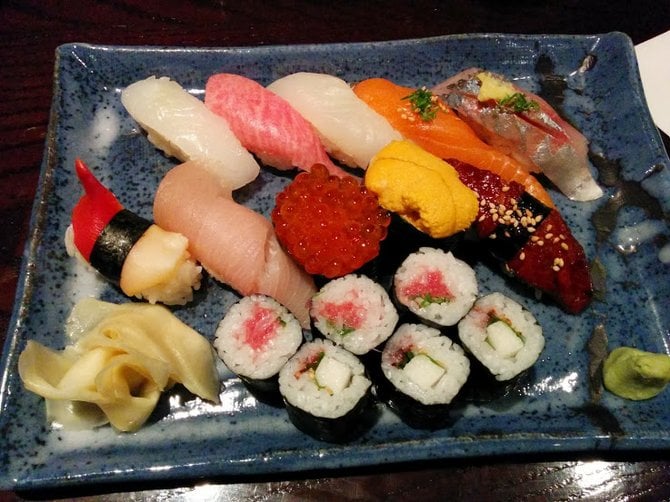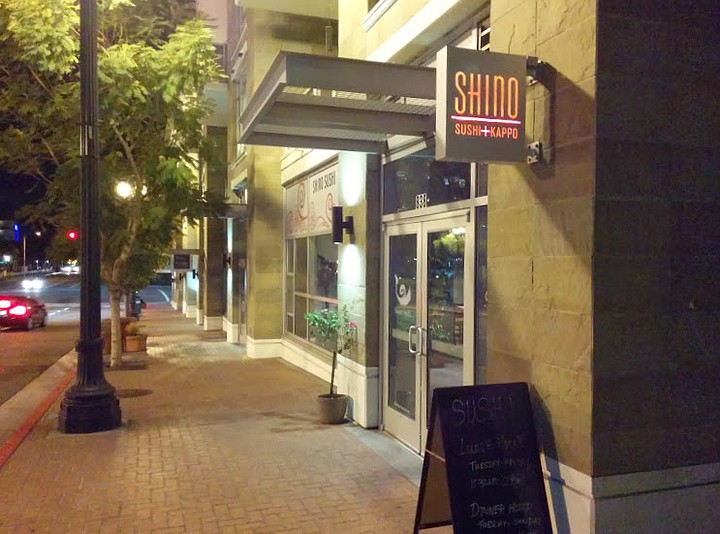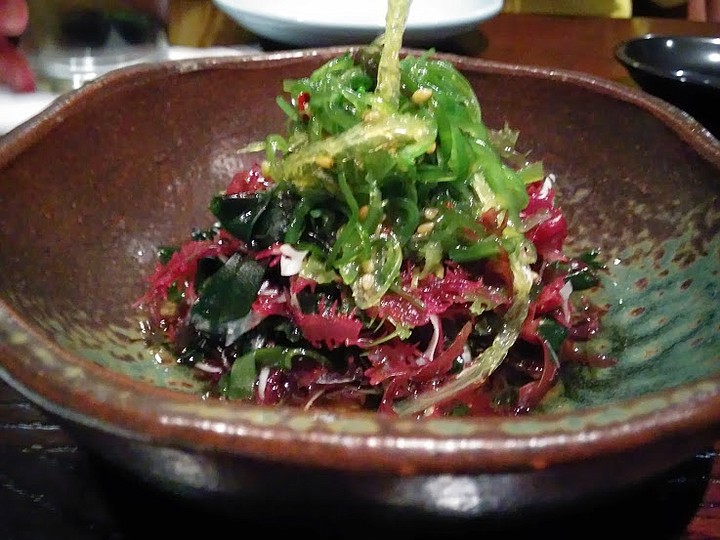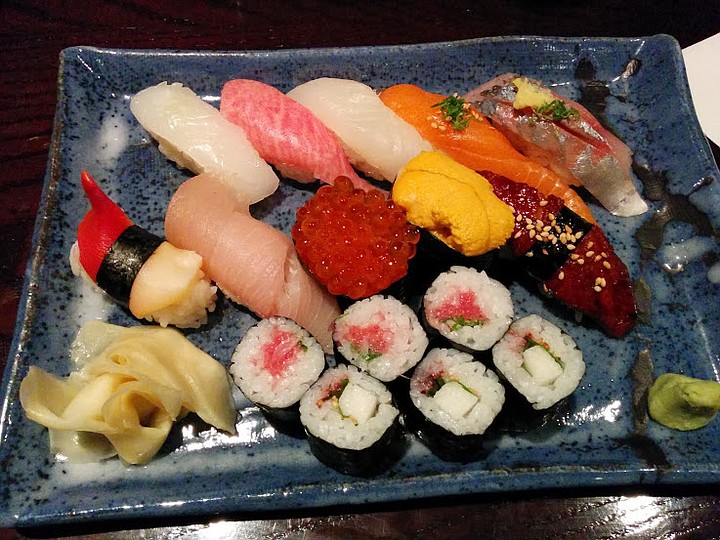 Facebook
Facebook
 X
X
 Instagram
Instagram
 TikTok
TikTok
 Youtube
Youtube

Rumors of Shino Sushi + Kappo have percolated up through the usual channels. People say that chef Robert Nakamura —brother of Hane Sushi’s Roger Nakamura — produces elegant and indulgent sushi, having learned a trick or two working at Sushi Ota. And much like Ota, Shino is a true sleeper, without a proper website or any of the glitz and glamor that often accompanies fine restaurants. After dark, it’s easy to pass Shino by on its desolate block in Little Italy, with only train tracks and high rises for company.

Inside, the spartan concrete furnishings reveal little, but diners gush as they make their way to the exit.
“Oh my god, that was the best sushi!”
Et cetera.
The rumors proof. Shino is exceptional. Even a plate of seaweed salad tells the whole truth. Instead of the dyed-green strings of jellied kombu sold everywhere else, Shino's salad is this little, perfect composition of rainbow seaweeds. Each piece distinct, briny, and dressed lightly with fine rice vinegar and some goma (sesame seeds), served in the thickly glazed ceramics for which the restaurant is named.

Plates of sushi present gorgeous jewels of fish and rice. Asking for the $32 “sushi combo special” sounds crass, as if it were copied form the menu at Sushi Deli, but the platter includes marbled chu-toro, uni, spear squid that dissolves into a rush of briny freshness, buttery yellowtail, and chopped toro rolls, to name a few.

But go beyond the special combo, and there is Japanese amberjack, almost impossibly tender and succulent.
Raw octopus, simply refreshing.
Zuke (marinated) tuna, which looks like a polished gemstone and finishes with the perfect zing of yuzokoshō chili paste.
There is o-toro, richer than the best lardo and laced with the taste of the salty blue water where the tuna hunt.
Of course, sushi is rice, and Shino’s rice exceeds expectations. Without too much sugar or vinegar, it’s an exercise in pointed understatement. Where some chefs play with rice to give it character, Nakamura’s kitchen makes rice that acts like a gessoed canvas for the masterstroke of exceptional fish. Teased into form by the chefs’ experienced hands, each bite seems tightly compacted and solid until it crumbles into perfect grains.

Shino lacks real flaws. Imperfections are slight enough that their mention constitutes little more than quibbling. Putting soy sauce, and even extra wasabi, on the table invites diners to question the chef’s judgment, which proves 99% impeccable. Nakamura might go a hair too heavy on the wasabi, but only in very rare instances and in a manner that comes down to personal taste. It’s only worth mentioning because the fact that noticing such a small thing, really the merest shadow of doubt, somehow highlights excellence.
It calls to mind a minor character from a William Gibson novel, an old man who lives in a cardboard box at a Tokyo subway station. He paints Gunndam model robot figures with fervent obsession, “perhaps leaving each one with a single minute and somehow perfect flaw, at once his signature and a recognition of the nature of the universe. How nothing is perfect, really. Nothing ever finished. Everything is process.”
And the process of dining at Shino approaches the sublime.


Rumors of Shino Sushi + Kappo have percolated up through the usual channels. People say that chef Robert Nakamura —brother of Hane Sushi’s Roger Nakamura — produces elegant and indulgent sushi, having learned a trick or two working at Sushi Ota. And much like Ota, Shino is a true sleeper, without a proper website or any of the glitz and glamor that often accompanies fine restaurants. After dark, it’s easy to pass Shino by on its desolate block in Little Italy, with only train tracks and high rises for company.

Inside, the spartan concrete furnishings reveal little, but diners gush as they make their way to the exit.
“Oh my god, that was the best sushi!”
Et cetera.
The rumors proof. Shino is exceptional. Even a plate of seaweed salad tells the whole truth. Instead of the dyed-green strings of jellied kombu sold everywhere else, Shino's salad is this little, perfect composition of rainbow seaweeds. Each piece distinct, briny, and dressed lightly with fine rice vinegar and some goma (sesame seeds), served in the thickly glazed ceramics for which the restaurant is named.

Plates of sushi present gorgeous jewels of fish and rice. Asking for the $32 “sushi combo special” sounds crass, as if it were copied form the menu at Sushi Deli, but the platter includes marbled chu-toro, uni, spear squid that dissolves into a rush of briny freshness, buttery yellowtail, and chopped toro rolls, to name a few.

But go beyond the special combo, and there is Japanese amberjack, almost impossibly tender and succulent.
Raw octopus, simply refreshing.
Zuke (marinated) tuna, which looks like a polished gemstone and finishes with the perfect zing of yuzokoshō chili paste.
There is o-toro, richer than the best lardo and laced with the taste of the salty blue water where the tuna hunt.
Of course, sushi is rice, and Shino’s rice exceeds expectations. Without too much sugar or vinegar, it’s an exercise in pointed understatement. Where some chefs play with rice to give it character, Nakamura’s kitchen makes rice that acts like a gessoed canvas for the masterstroke of exceptional fish. Teased into form by the chefs’ experienced hands, each bite seems tightly compacted and solid until it crumbles into perfect grains.

Shino lacks real flaws. Imperfections are slight enough that their mention constitutes little more than quibbling. Putting soy sauce, and even extra wasabi, on the table invites diners to question the chef’s judgment, which proves 99% impeccable. Nakamura might go a hair too heavy on the wasabi, but only in very rare instances and in a manner that comes down to personal taste. It’s only worth mentioning because the fact that noticing such a small thing, really the merest shadow of doubt, somehow highlights excellence.
It calls to mind a minor character from a William Gibson novel, an old man who lives in a cardboard box at a Tokyo subway station. He paints Gunndam model robot figures with fervent obsession, “perhaps leaving each one with a single minute and somehow perfect flaw, at once his signature and a recognition of the nature of the universe. How nothing is perfect, really. Nothing ever finished. Everything is process.”
And the process of dining at Shino approaches the sublime.
Comments